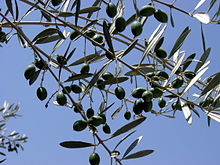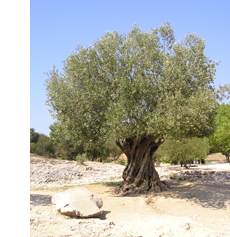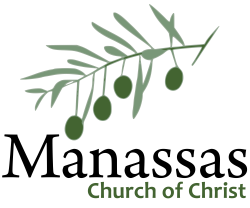Olive branch
 The olive branch is usually a symbol of peace or victory and was historically worn by brides. This symbol, deriving from the customs of Ancient Greece, is strongest in Western culture. However, it has been found in every culture and religion to thrive in the Mediterranean basin.
The olive branch is usually a symbol of peace or victory and was historically worn by brides. This symbol, deriving from the customs of Ancient Greece, is strongest in Western culture. However, it has been found in every culture and religion to thrive in the Mediterranean basin.
Early Christianity
The olive branch appears with a dove in early Christian art. The dove derives from the simile of the Holy Spirit in the Gospels and the olive branch from classical symbolism. The early Christians, according to Winckelmann, often allegorised peace on their sepulchres by the figure of a dove bearing an olive branch in its beak. For example, in the Catacomb of Priscilla in Rome (2nd – 5th centuries CE) there is a depiction of three men (traditionally taken to be Shadrach, Meshach, and Abednego of the Book of Daniel) over whom hovers a dove with a branch; and in another of the Roman catacombs there is a shallow relief sculpture showing a dove with a branch flying to a figure marked in Greek ΕΙΡΗΝΗ (Eirene, or Peace).
Tertullian (c.160 - c.220) compared Noah's dove in the Hebrew Bible, who "announced to the world the assuagement of divine wrath, when she had been sent out of the ark and returned with the olive branch". with the Holy Spirit in baptism "bringing us the peace of God, sent out from the heavens". In his 4th century Latin translation of the story of Noah, St Jerome rendered "leaf of olive" (Hebrew alay zayit) in Genesis 8:11 as "branch of olive" (Latin ramum olivae). In the 5th century, by which time a dove with an olive branch had become established as a Christian symbol of peace, St Augustine wrote in On Christian Doctrine that, "perpetual peace is indicated by the olive branch (oleae ramusculo) which the dove brought with it when it returned to the ark." However, in Jewish tradition there is no reference to an olive branch in the story of the Flood and no association of the olive leaf with peace.
Olive
That the olive signifies the good of charity, is evident from the signification in the Word not only of an olive, but also of oil. It was with olive oil, together with spices, that the priests and kings were anointed, and it was with olive oil that the lamps were trimmed (Exod. 30:24; 27:20). The reason olive oil was used for anointing and for lamps was that it represented all that is celestial, and therefore all the good of love and of charity; for the oil is the very essence of the tree, and is as it were its soul, just as the celestial, or the good of love and of charity, is the very essence or the very soul of faith; and hence oil has this representation. That oil signifies what is celestial, or the good of love and of charity, may be confirmed from many passages of the Word; but as it is the olive-tree that is mentioned here, we will merely present some passages that confirm its signification. As in Jeremiah:--
Jehovah called thy name a green olive-tree, fair with goodly fruit (Jeremiah 11:16),
where the Most Ancient or Celestial Church is so called, which was the foundation church of the Jewish Church; and therefore all the representatives of the Jewish Church had regard to celestial things, and through these to the Lord.
[2] In Hosea:--
His branches shall spread, and his honor shall be as the olive-tree, and his smell as of Lebanon (Hosea 14:6),
which is said of the church that is to be planted, whose honor is the olive-tree, that is, the good of love and of charity; the smell as of Lebanon, being the affection of the truth of faith therefrom. Lebanon" stands for its cedars, which signified spiritual things, or the truths of faith. In Zechariah, speaking of the lampstand:--
Two olive-trees by it, one upon the right side of the bowl, and the other upon the left side thereof; these are the two sons of the pure oil that stand by the Lord of the whole earth (Zechariah 4:3, 11, 14).
Here the two olive-trees denote the celestial and the spiritual, thus love, which is of the celestial church, and charity, which is of the spiritual church. These are on the right hand and on the left hand of the Lord. The lampstand here signifies, as in the Jewish Church it represented, the Lord; its lamps signify celestial things from which are spiritual, as from a flame proceed rays of light, or light. In David:--
Thy wife shall be as a fruitful vine in the sides of thy house; thy sons like olive-plants (Ps. 128:3);
where wife as a vine, denotes the spiritual church; sons the truths of faith, which are called olive-plants, because from the goods of charity. In Isaiah:--
Yet there shall be left therein gleanings, as the shaking of an olive-tree, two or three berries in the top of the branch (Isaiah 17:6);
where the subject treated of is the remains in man; of an olive-tree, denoting celestial remains. In Micah:--
Thou shalt tread the olive, but shalt not anoint thee with oil; and the vintage, but shalt not drink the wine (Micah 6:15).
And in Moses:--
Thou shalt plant vineyards and dress them, but thou shalt not drink of the wine; thou shalt have olive-trees throughout all thy border, but thou shalt not anoint thyself with the oil (Deut. 28:39, 40),
where the subject is the abundance of doctrinal teachings about the goods and truths of faith, which by reason of their character, those people rejected. From these passages it is evident that a leaf signifies the truth of faith, and an olive the good of charity; and that like things are signified by the olive-leaf which the dove brought in her mouth; that is, that there now appeared in the man of the Ancient Church some little of the truth of faith from the good of charity.
Olive tree
 Even today the olive tree has retained its symbolic power amongst the different cultures and nations.
Even today the olive tree has retained its symbolic power amongst the different cultures and nations.
- The tree of wisdom: In several cultures the tradition says that the olive tree was gifted to from gods to people. Thus, the symbol of goddess Athena beside the owl symbolized an olive branch.
- The tree of peace: Irena, the god of peace, daughter of Zeus and Themed, was always depicted with an olive branch in her hand. Later, in periods of war, the couriers of peace were sent holding a symbolic olive branch in their hand.
- The tree of hope: In the Old Testament a dove returns with an olive branch in the ark, in order to announce the end of flood and bring hope to people.
- The tree of light: The olive oil was used as lighting oil and thus it was considered to be source of light.
- The tree of fertility: In folk tradition of Greek medicine the olive oil is considered to be aphrodisiac. People offered to new couples bread in oval shape were they previously purred the first oil of the year, as an antidote to sterility.
- The tree of health: The value of olive oil to the health is widely known for centuries. Thus, the olive tree symbolizes power and health. Moreover, this symbolism is totally accurate due to the fact that olive trees are long-lived, simple and resistant.
- The tree of wealth: For many families the olive trees and their products represent the main source of income.
- The tree of balance: The olive tree was considered to be the tree of balance by the Celts. For this reason they devoted the day of 23rd of September to it as that particular date the day has the same duration as the night.


